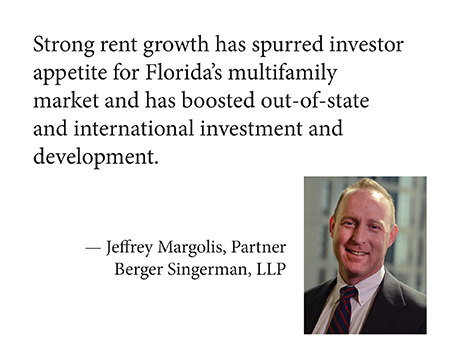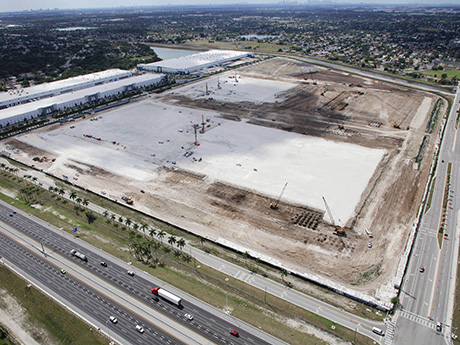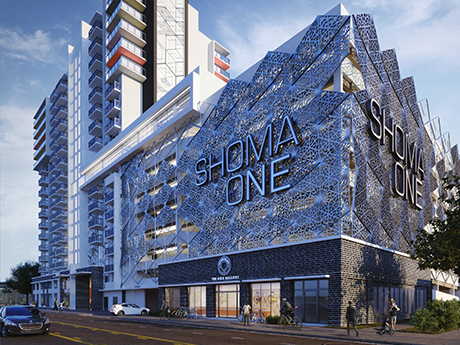There is an overall sentiment that the Southeast multifamily real estate market, and specifically Florida, is doing better than any other region in the United States. Despite record inflation, rising interest rates, increased construction costs and supply chain issues, investors, developers and lenders are becoming increasingly bullish when it comes to the Florida multifamily market. A rising population count resulting in a swift pace of rent growth and tight apartment vacancy have led to increased out-of-state and international interest and capital being invested in the state. With competitive yields and better returns compared with alternative investments, investors view Florida multifamily projects as a sound opportunity. Florida has been less stringent when it came to COVID-19 policies and lockdowns compared with restrictions adopted in the Northeast and on the West Coast. Limited and lenient state-wide restrictions in Florida during the health crisis allowed the state’s economy to recover more quickly than most major U.S. markets. In addition to an established migration of retirees, Florida has attracted a younger population, with workers looking for warmer climates and relaxed COVID-19 policies. Similarly, massive migration from other regions is being fueled by the ease of doing business, a favorable regulatory environment, business-friendly tax rates, …
Market Reports
Amid a record-breaking year for Miami-Dade County in 2021, industrial market fundamentals grew even stronger in the first quarter of 2022. Last year, the national industrial market saw unprecedented activity resulting from unlimited investment capital from Wall Street, private equity firms and REITs deploying significant capital into buying existing income-producing property and development sites. In the first quarter of 2022, market fundamentals continued to heat up in Miami-Dade County and are expected to continue to attract investors and developers that are looking to capitalize on a growing population and soaring demand for warehousing space. The ongoing global supply chain challenges are forcing existing tenants’ requirements to include additional warehouse space for storage. Simultaneously, new-to-market tenants are continuing to flock to the area, despite a shrinking supply of available space. Together, this confluence of activity triggered a record low vacancy rate of 2.7 percent in Miami-Dade County in the first quarter, a 150-basis-point decrease year-over-year. Rental rates also reached a record high of $11.80 per square foot triple-net, which is an increase of 8.3 percent year-over-year. We expect continued growth in port markets, as well as increased leasing activity from third-party logistics and e-commerce tenants. In 2021, Amazon leased multiple locations …
The Sky is Not Falling for Miami’s Retail Market as Healthcare, Dining Activity Soars
by John Nelson
When the world shut down in March 2020, “Chicken Littles” everywhere proclaimed the end of one of the primary asset classes in commercial real estate: retail. Retail tenants largely abandoned expansion plans and entered survival mode by shifting focus to seeking rent abatements and lease restructurings. Landlords in weak financial positions fought to meet significant debt obligations, while those in stronger positions took the opportunity to evict struggling tenants and refresh inventory, hoping that more creditworthy tenants would come calling. Fast forward two years and any lingering uncertainty about the survival of retail has waned, and, today, we seem to be in one of the stronger landlord markets in recent memory. What drove this radical shift from fear and hesitation to boundless market optimism? Increased competition among tenants with strong financial backing. Two factors have changed the landscape: private equity-sponsored healthcare companies and capital-rich restaurant groups. Medtail in Miami Healthcare businesses appeared to thrive during the pandemic as most were able to remain operational through state and local “shut down” orders. Many of these businesses used the pandemic as an opportunity to pounce on large spaces vacated by big box retailers and service-oriented businesses, like nail salons, barbershops and dry …
Miami’s multifamily market slowed down dramatically at the start of COVID-19 and now has quickly rebounded to record levels. Collections and occupancies are excellent, new supply is quickly absorbed, population/household growth is on fire, the job market has largely rebounded, wages are up, home prices are at record levels — meaning more people are renting — and limited land is keeping construction in balance. Going forward, the market is ideally positioned for continued long-term growth thanks to positive market fundamentals and continued strong sales activity. Demand for rentals was strong pre-pandemic and will grow even greater in the post COVID-19 era as South Florida continues to increase its resident count. Between 2020 and 2021, South Florida added 42,842 residents, including 14,318 new residents in Miami-Dade County. With the influx of residents, South Florida is expected to have over 37,000 new households created each year over the next five years. That represents over 14,800 new renters per year, assuming 60 percent of households enter homeownership and 40 percent rent, which is in line with historical ratios. Record year for sales 2021 was a record-setting year for the South Florida multifamily market. The region experienced 603 multifamily sales totaling $11.4 billion, which …
As COVID-19 took hold in early 2020, the Orlando retail market only saw a modest dip in fundamentals where metro-wide rental rates fell by 5 percent and occupancy dropped 100 basis points during the second and third quarters. Beginning in the fourth quarter of 2020, rental and occupancy rates began an extraordinarily strong comeback, climbing 12 percent and 140 basis points, respectively, from the COVID-19 lows. According to data from CoStar Group, the metro’s average rental rate of $15.84 per square foot in the second quarter is more than 7 percent higher than the pre-pandemic peak. And occupancy rates are 40 basis point higher than the pre-COVID-19 peak, currently standing at 96.4 percent. With escalating land prices and shortages in raw materials and labor, we anticipate overall construction costs will continue to increase, stalling deliveries and further advancing rental and occupancy rates. Last year, some retail owners (sellers) and investors (buyers) focused on asset management within their portfolios and reevaluated the perceived investment risk due to the pandemic, which caused a sharp dropoff in 2020 investment activity, despite an abundance of capital available to invest. After a couple quarters of fundamentals bottoming out, owners and investors had confidence in their …
Contrary to what is often portrayed in the national media, the Orlando office market is not a monolith. It instead comprises multiple submarkets, many of which are recovering quite differently. For example, according to data from CoStar Group, Winter Park had a 4.7 percent availability rate (that’s direct and sublease space combined). The Downtown Orlando market, on the other hand, had a rate of 16.9 percent. The total Orlando MSA office availability rate was 11.5 percent, which compares to the national rate of 16 percent. All of these numbers just prove that the recovery from the pandemic is uneven, even in areas in close proximity. It’s easy to get lost in analysis, but the basic answer is that the office market in Orlando, just like in the entire country, will recover in time. Not all areas will be on the same timeline, and the office market will never look entirely the same. Between working from home and companies deciding to relocate their offices or headquarters entirely, there will be some short-term winners and losers. Texas, for instance, is having a relative boom in new tenants. Los Angeles, and indeed California in general, on the other hand, is not. Many companies …
Orlando’s industrial market emerged from the early panic of 2020 in solid shape, and both occupier and investment activity have continued in earnest ever since. While the preceding year has brought its share of pandemic-induced challenges to the Orlando market, the industrial sector itself has not been adversely affected, other than by labor shortages and the escalating prices of construction materials for new development. Sector fundamentals remain strong, with healthy leasing and positive net absorption of space, robust tenant activity and continued speculative development that is focused primarily along the 429 Corridor and in the Orlando Central Park and Airport/Southeast submarkets. Economic fundamentals are also sound. The unemployment rate in Orlando as of June 2021 was 6 percent, down an impressive 1,300 basis points from the height of pandemic unemployment in May 2020. Oxford Economics projects that Orlando is expected to see job growth of 2.1 percent in 2021, 9.1 percent in 2022 and should recover all of its lost jobs by third-quarter 2022, a majority of which are in the leisure and hospitality sector. Central Florida is the state’s fastest-growing region, and the U.S. Census Bureau expects its growth to outpace South Florida by a factor of two to …
Miami’s Restaurants are Back on Track, Entertainment and Big Box Users are Still Healing
by John Nelson
What a difference a year makes! Retail real estate in Miami is not dead nor in the depths of huge vacancy rates and declining rents; current vacancy rate is 4.3 percent and rental rates have slipped by 0.1 percent over the past year. Let’s explore several indicators of the value and use of the current state of the shopping center industry, restaurant space, entertainment space and big-box retailers. South Florida restaurant space, due to COVID-19 restrictions, was not open to customers over the last 18 months. Many anticipated only a few restaurants to survive with lots of second-generation restaurant space expected to be given back to landlords. Due to the U.S. Small Business Administration’s Paycheck Protection Program and restaurateurs flocking to Miami from across the country — mainly the Northeast, especially New York City — the glut of restaurant space vacancy never occurred. When there is available second-generation restaurant space, it gets leased quickly. South Florida has seen national chain quick-service restaurants (QSR) looking for ghost kitchens which restricts customers to pick-up and delivery. Restaurant sales are back to pre-COVID-19 levels beginning the second quarter this year. The restaurant market appears to be healthy, again. News is not so great …
The past year has been a long and winding ride, and some unexpected trends have been taking place in the Miami office market, between the onset of the COVID-19 pandemic and through its recovery to date. Logically, one would expect that an ongoing pandemic keeping corporate offices closed and employees working from home would negatively affect occupancy levels and lead to a deceleration in asking rents for office space. On the contrary, the Miami office market has remained solid, and while the area is a natural draw for tourism and entertainment, an increasing number of companies also recognize it as a sought-after location from which to operate their businesses. Tech’s influence on rents Miami has been one of the most active office markets in the nation thus far in 2021. While office markets in the Northeast and California remain partly closed due to several public health initiatives and related business constraints, Miami’s pro-business culture — coupled with Florida’s lack of state income taxes and business development efforts rolled out by Miami Mayor Francis Suarez and the Miami-Dade County Beacon Council — have ensured that the city’s economic engine kept running. Case in point, not only did Class A rental rates …
South Florida multifamily fundamentals are, and will continue to be, the single biggest driver of performance in the market. Strong rent collection and occupancy performance through the pandemic, population and household growth, low homeownership rates, increasingly expensive home prices, an improving job market, higher wage growth, limited land and a wonderful lifestyle all contribute toward sustainable long-term growth. Demand for multifamily rentals will increase post COVID-19 as South Florida becomes a hotbed of population growth from people migrating from other states due to the business-friendly environment and tele-workers who are choosing South Florida as their new home. In fact, household formations in South Florida are expected to increase more than 44,000 each year over the next five years. Assuming this projection materializes, at 60 percent homeownership rate (consistent with historic homeownership rates) represents over 17,000 new renters per year in South Florida. Investment sales skyrocket In the span of less than 12 months, the South Florida multifamily market went from near-record sales activity to virtually none before rebounding again to close the year. Last year ended with 254 multifamily sales totaling $3.1 billion. Despite almost six months of virtually no investment activity from April through September, total sales volume was …









